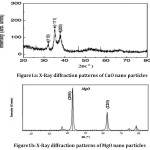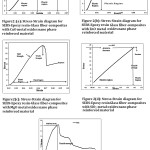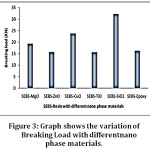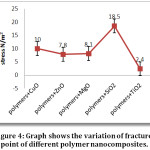Introduction
It is important to calculate the strain and stress distributions to know the mechanical behaviour of composites. Composite applications are mostly found in automotive, aeronautical and sports arena. Moreover, they are used in making wind turbines, storage tanks, machinery parts and medical equipment. They become the first choice of the industries because of their unique mechanical and physical properties. Their composition, their structures and the distribution of the phases define the properties of composites. Glass fibre reinforced with epoxy composites gives an attractive combination of physical and mechanical properties.1, 2 The mechanical properties of the composites can be improved by reinforcing various nano filler materials. These nano fillers act as additional reinforcing components in the composites. The properties of these composites depend on the type, shape and size of the filler material.3, 4
Failure mechanism of the polymer composite material is a recent field of study and also one of the important points to discuss in material engineering. Stress-strain analysis the recent ongoing studies in composite materials to find their breaking points. It is found that the failure mechanism depends on the applied stress. Also, the direction of applied stress is relative to the direction of fibre reinforced in the matrix. Hence it is necessary to study the stress component and its analysis of the composite materials. The properties of polymer composites depend on the constituent material, fibre reinforcement, polymer matrix, size of the fibre and its geometry.
Fibre reinforced polymer (FRP) composites are materials composed of a polymer matrix combined with fibre reinforcements. Polypropylene is one of the toughest thermoplastic materials. Due to its low cost, low density, high heat distortion temperature, processability and extraordinary versatility in terms of tailored properties, it is widely used. Tensile loading of the specimen have produced different failure types and researchers have studied the inhomogeneity of the matrix.5 Research interest has been focused on towards fibre-reinforced polymeric composites as these composite materials exhibit excellent mechanical properties. Parvanesh et al.,6 studied the mechanical behaviour of PVC nano composites. They have studied the Young’s Modulus and tensile strength of polymer composites and the result suggested that good stress transfer can be obtained at an amorphous interface, depending on the polymer.
As a composite material is subjected to various stresses, the load is transformed from the polymer matrix to the fibre through the interfacial bonding interaction. The reinforcing composites may be in the form of fibres, particles or flakes. Continuous matrix materials are generally used in composites.7 It was found that the adhesion bond of the resin matrix increases the mechanical properties of polymer composites. Jagannatha and Harish8 have studied the effect of glass and carbon fibre reinforced with the epoxy polymer matrix. They studied the breaking load and tensile properties of fibre reinforced composites. They concluded that the addition of carbon fibre reinforcement in the polymeric composite enhanced the ultimate tensile strength, yield strength and maximum load of the composite. Zhang et al.,9 have also studied the mechanical behaviour of hybrid carbon/glass reinforced composites and they compared the flexural stress-strain data of different composites and they concluded that the composite system exhibited more failure under the flexural loading. Jarukumjorn Kasama, Suppakarn Nitinat and W.H. Leonard et al.,10-11 investigated the mechanical properties and fracture behaviour of glass fibre-reinforced polyester composites. The comparative investigations of these new nano composites were performed in order to estimate their competitiveness.
Nano metal oxide reinforcement also controls the strength and stiffness of fibre composites. Current fracture mechanism based on stress-strain analyses and mechanical behaviour is found to be suitable for describing the behaviour of composites at different loads. In the present work, the elastic ranges, plastic ranges, and deformation/fracture points are measured by the stress-strain analysis of Styrene-Ethylene-Butylene-Styrene (SEBS)-epoxy resin polymer composites reinforced withCuO, ZnO, MgO, SiO2 and TiO2 nanophase materials. It is found that the composite in each case showed a nonlinear elastic relation between stress and strain and its behaviour varies depending on the reinforcements.
Materials and Methods
Materials
Commercial styrene-Ethylene-Butylene-Styrene (SEBS), epoxy resin (LY 556), hardener (HY 951), glass fibre (MATWRM 619 GSM)were used to make a composite. Epoxy Resin is a base material on the glass plate, which is purchased from M/s. Om Sakthi Techno Services. SEBS was used to make a composite film, which is purchased from M/s Kraton polymers. Mumbai. Nano powders were synthesized by a sol-gel method in our physics Laboratory, Sathyabama University. Bidirectional Glass fibre- WRM 610 GS woven roving mat was used for reinforcement in the polymer matrix.
Synthesis of Nano phase material by a sol-gel method
CuO nano-powders were prepared by sol-gel method. An aqueous solution of CuCl2.6H2O (0.2 M) was prepared in the clean round bottom flask. 8 Ml NaOH is added to the above solution until the pH reached to 6-8. The colour of the solution turned dark blue immediately and a large amount of black precipitate was formed at the bottom of the flask. The precipitate was centrifuged and washed 5 times with distilled water. The obtained precipitate was dried in air for 4 h. CuO nano powder was obtained and it was used for the characterization of the material.
MgO nano crystals were prepared by reaction of an aqueous solution of 0.1 M of Mg(NO3)2 and 0.51M NaOH using deionized water. White precipitation was induced by adding NaOH into the Mg(NO3)2 solution by continuous stirring for 3 h in room temperature. The resultant mixture was cooled to room temperature, centrifuged and washed with distilled water and ethanol for removal of impurities. The final product was dried at 100˚C for 4 h and calcinated at a particular temperature.
Size of the particles was measured by XRD analysis using the Debye-Scherer equation and the average size of the particle was confirmed between 45-65nm. XRD pattern of CuO and MgO are given in Figure1 (a) and 1(b), respectively.
Figure 1 a: X-Ray diffraction patterns of CuO nano particles
Figure 1 b: X-Ray diffraction patterns of MgO nano particles
100 ml of Zn(NO3), 6H2O aqueous solution and 100 ml of NaOH aqueous solution were mixed to obtain Zn(OH)2 precipitate. The precipitate was separated from the solution by a centrifuge at 3000 rpm for 5 min. The obtained Zn(OH)2 was dispersed in distilled water and was again separated by a centrifuge. This procedure was repeated 3 times, and the impurities in the precipitate were removed. The Zn (OH)2 was then dispersed in 50 ml of H2O2 aqueous solution whose concentration was 1 mol/1. The dispersed solution was heated at 348 K in a closed glass vessel (200 ml). The resultant solution was a translucent sol of the zinc peroxide nanoparticles. The obtained sols were dried at 348 K for 6 h. The obtained powder was kept at 453 K temperatures for 2 h to prepare ZnO particles.
The TiO2 powder was prepared by the sol-gel process using Ti(OC3H7)4 and ethanol as used as a solvent. After the dissolution of 11.4 ml of Ti(CO3H7)4 in ethanol solvent, a solution of 0.75 ml water in ethanol was mixed and 1.5 ml C4H11NO2 added dropwise method under continuous stirring to realize a transparent sol-gel. The sol was digested for 24h and dried subsequently at 100°C for 8h and calcinated for 2h and cooled.12-15
Nano SiO2 was prepared through hydrolysis of Si(OC2H5)4 via the following route
Si(OC2H5)4+4 H2O → Si(OH)4 + 4C2H5OH
pH 11-12 (NH3)
Followed by poly-condensation of Si(OH)4
Si(OH)4→ nano-SiO2+2H2O
pH 11-12 (NH3)
Fabrication of Nano composites
To fabricate the composite film, commercial bi-directional glass fibre, epoxy resin and styrene-ethylene-butylene-styrene were used. The resin was coated on the surface of a glass plate which was used for casting the composite. Nano powders were weighed and mixed with SEBS in a particular ratio uniformly by magnetic stirring for 1 h continuously. After the uniform mixing with the resin, nano particles were dispersed in the solution. The above-prepared solution was used for making the film. WRM 610 GS woven roving mat-bi directional glass fibres reinforced on the film and again the SEBS with nano powder solution was poured on the film. Finally, the fibre reinforced polymer film was prepared with a thickness of 4 mm and curing was done by keeping the material for 24 hrs. During this process, the pressure is applied to the composite film (50 Bar) at 80°C. The final laminates consisted of resin, glass fibre and nano crystals dispersed polymer matrix.
Tensile Test
Test specimens were taken from the composite sheets. Unidirectional tensile specimens were cut out of the laminates in both fibre and matrix directions according to ASTM D3039. Breaking load of different composites were determined from the stress-strain diagram. Mechanical tests often involve the deformation or breakage of samples of a material called test specimens. The specimen size was 260 mm×24 mm×4mm. The different composite specimen samples were tested in the Universal Testing Machine (UTM) and in each case, the material was allowed to break to find the ultimate tensile strength.
Results and Discussion
The mechanical properties of an SEBS-Epoxy resin with nanometal oxides are given in Table.1. Young’s modulus, also known as the tensile modulus or elastic modulus, is a measure of the stiffness of an elastic material and is a quantity used to characterize materials. Young’s modulus may have different values depending on the direction of the applied force with respect to the structure. As tensile stress is applied to the composite material, elongation of material takes place. Elongation is inversely proportional to hardness, tensile strength and elastic modulus of the material. That is, greater the hardness, tensile strength, and modulus, lesser will be the elongation under stress and it takes more force to stretch a hard material, which is having high tensile strength. A stress-strain curve is drawn to find the ultimate tensile strength and elastic modulus. In general, the stress in a composite material is defined as the change in the internal energy with respect to the strain per unit volume.
Table 1: Experimental data of Maximum Extension, Tensile strength, Elongation and Young’s modulus of Styrene-Ethylene-Butylene-Styrene (SEBS) -Epoxy composite Reinforced with different nano metal oxides.
|
Polymer matrix
|
Reinforced Nano metal oxides
|
Max. Force (K/N)
|
Distance (Fm)
|
Maximum Extension (mm)
|
C/S Area mm2
|
Tensile Strength (kN/mm2)
|
Elongation (%)
|
Young’s Modulus (kN/mm2)
|
|
SEBS
|
MgO
|
19.320
|
7.300
|
0.592
|
122.400
|
0.158
|
5.533
|
13.572
|
|
SEBS
|
ZnO
|
15.740
|
5.800
|
0.398
|
123.750
|
0.127
|
3.867
|
13.680
|
|
SEBS
|
CuO
|
16.250
|
7.500
|
0.438
|
125.600
|
0.173
|
5.350
|
14.211
|
|
SEBS
|
TiO2
|
15.660
|
8.700
|
0.308
|
114.400
|
0.137
|
8.200
|
15.382
|
|
SEBS
|
SiO2
|
17.200
|
8.230
|
0.440
|
122.300
|
0.290
|
7.700
|
13.433
|
|
SEBS
|
Epoxy Resin
|
15.520
|
5.720
|
0.411
|
122.500
|
0.121
|
4.110
|
13.699
|
The stress-strain graph of the composite shows a ductile/brittle nature. The effect of strain rate on stress-strain behaviour of composite materials measured at room temperature and it shows that the mechanical properties of the material strongly depends on the rate of strain. The variation of stress-strain for the glass-reinforced SEBS-polymer doped with CuO, ZnO, MgO, SiO2 and TiO2 metal oxides nanophase material is shown in Figure2(a)-2(e). When a polymer composite has been subjected to a tensile test, it passes various stages before fracture.
Figure 2 (a)-(e):-
(a): Stress-Strain diagram for SEBS-Epoxy resin-Glass fibre-composites with CuO metal oxides nano phase reinforced material
(b): Stress-Strain diagram for SEBS-Epoxy resin Glass fibre-composites with ZnO metal oxides nano phase reinforced material
(c): Stress-Strain diagram for SEBS-Epoxy resin-Glass fibre-composites with MgO metal oxides nano phase reinforced material
(d): Stress-Strain diagram for SEBS-Epoxy resin Glass fibre-composites with SiO2 metal oxides nano phase reinforced material
(e): Stress-Strain diagram for SEBS-Epoxy resin
Glass fibre-composites with TiO2 nano phase reinforced the material.
The stress-strain curves show considerable nonlinearity before reaching the breaking stress, i.e. they show apparently-brittle structure. Each curve shows maximum stress, which is assumed to be the flexural strength of the material. This should be due to the strong adhesive force between the fibres and polymer matrix.16 The result shows that the composite doped with TiO2nanoparticles (NPs) has a low tensile strength as compared to other metal oxide reinforcements and that the stress-strain rate is high in the case of MgO doped material. But the composite reinforced with SiO2 NPs is perfectly linear in variation and it shows characteristics of brittle nature of the material. The nanometal oxides and fibres provide bonding sites to the polymer matrix so that the entire load could be transferred to the fibres and prevent separation between the polymer surfaces and matrix.
Figure 3 shows the variation of breaking load with different nanophase materials. From the above graph, it is understood that the SEBS-Epoxy with SiO2 composites have the highest value while the composites reinforced with TiO2 & ZnO have the lowest value of breaking loads. Due to the reinforcement of the SiO2 nano particles, more hydrogen bonds are formed between SiO2 and matrix and it is concluded that the size of the nanophase material can directly affect the behaviour of composites. These findings are consistent with earlier researchers, who reported mechanical property has enhanced by the addition of various nanofillers in polymer composites.17-18
Figure 3: Graph shows the variation of Breaking Load with different no phase materials.
Effect of Fiber and metal oxide reinforcement on deformation
Nanocomposites with CuO, ZnO2, and TiO2 metal oxides had similar stiffness as compared to other materials. The composite with MgO2 has high stress-strain rate and it has a high tensile strength at the stress rate of 14 MPs, while the composite with SiO2 has linear variation and it shows a brittle nature. This tensile strength occurred at the stress rate of 19 MPs. This type of behaviour is achieved only due to the reinforcement of nano phase material as they could provide bonding sites to the polymer matrix.
Figure 4: Graph shows the variation of the fracture point of different polymer nanocomposites.
There are some abnormal changes in the tensile strength and Young’s modulus of the polymer composites that have been observed due to the reinforcement of CuO NPs. It is also observed that elongation has also increased due to the dispersion of nano material. This is due to the effect of CuOnanofillers as the fillers act as a plasticizer19 whereas MgO is multipolar nano particles. More variations in elongation and tensile strength were observed due to polar attractive forces and van der Waals bonding interactions between the fillers and polymer matrix. Tensile strength is only slightly increased due to TiO2 NPs reinforcement as compared with the ZnOreinforcements.This is probably due to the stronger particle-particle interactionsTiO2 NPs with respect to their bonding to the matrix, leading to agglomeration whereby mechanical properties of the composites were reduced. This is also dependent on the formation of chain entanglement in the matrix.20
The stress-strain curves of CuO, ZnO and MgO and TiO2 bearing materials show similarities with ductile polymers. After reaching the yield point, the stress doped to the draw stress (dσd) remains constant in each material while the neck propagated through the entire length of the specimen to the fracture point. However, the variation of fracture strain depends on the nature of the nano fillers. The drop in fracture strain is caused by the transition from ductile to quasi-brittle fracture. The draw stress depends on adhesion between the polymer and the particles.21Variations of fracture point of different composites are shown in Figure 4. This variation of mechanical properties of composites depends mainly on the microstructure and the interface morphology of the polymer matrix and nano materials which includes the interfacial bonding, size and spatial distribution of the particles into the polymer matrix.22 When there is poor bonding interaction between the polymer matrix and particles, the composite becomes brittle as the applied load may not be transferred to the reinforcements.23
Conclusion
The stress-strain characterization and failure pattern of glass fibre reinforced- SEBS laminates with different nano phase materials under different loading conditions have been investigated. The stress-strain behaviour of laminates under different loads are measured until the breaking point. It varies depending on the nanofiller reinforcements. It is concluded that nano metal oxide reinforcements also controls the strength and stiffness of composites. Young’s modulus of SEBS composites increases with TiO2nano particles whileSEBS-with SiO2 nano phase material has high tensile strength and low Young’s modulus. Elastic region of the composites varied due to the reinforcement of nano metal oxides and it was measured as 0.01-0.035, 0.01-0.023, 0.12-0.147, 0.1-0.6, 0-0.03% for CuO2, ZnO, MgO2, SiO2, and TiO2respectively. Peak stress and strain increase with increasing SiO2 nano content. It is attributed to the effects of nano phase material on the plasticizer of composites.
Acknowledgement
Financial support was provided by ADE-(DRDO)-INDIA under Grant No. (No: ADE /14931 /3/ CARS/TMS). The author is grateful toDr.Jaisankar, Sr.Scientist, Polymer Division, Central Leather Research Institute, (CSIR), Chennai, India, for his support and guidance. The Author is also thankful to DST-FIST who has sponsored to the Department of Physics, Sathyabama Institute of Science and Technology, Chennai. Also, Author(s) are very thankful to Mrs.L.Karpagavalli, D.C.E., M.A., M.Phil. B.Ed., Principal, for her support in this work.
Funding Source
Financial support was provided by ADE-(DRDO)-INDIA under Grant No. (No: ADE /14931 /3/ CARS/TMS
 , E.Vengatesan2, A.Ramakrishnan2
, E.Vengatesan2, A.Ramakrishnan2 Material Science Research India An International Peer Reviewed Research Journal
Material Science Research India An International Peer Reviewed Research Journal






